The one page WordPress site administrator’s use the most is the login page. And most of us have tried to customize the look of that page in one way or another. However, despite providing a custom look, the login page does not always have to be a separate page.
On the contrary, you can easily put the login form in the sidebar. By doing that, you will be providing a simple log in solution for your visitors. The users will also feel encouraged to register into your site once they see the log in form.
Choosing the Plugin
While it is possible to add the log in form manually, we won’t go into that much hassle. Being a proud WordPress user, we have lots of third-party plugins for that purpose. For this tutorial, I will use Sidebar Login, an absolutely free plugin with more than seventy thousand active installs at this moment.





